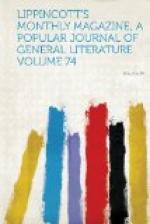Water, the simplest, most healthful and most indispensable of all refreshments, is provided without stint and without price. Foreigners are struck with the immense consumption of water as a beverage in this country. They do not realize the aridity of our summer climate, which makes it sometimes as much of a luxury here as it is in the desert. A rill of living water, let it issue from a mossy rift in the hillside or the mouth of a bronze lion, comes to us often like the shadow of a great rock in a weary land. We lead fevered lives, too, and this is the natural relief. Fountains are among the first decorations that show themselves in public or private grounds. They give an excuse and a foothold for sculpture, and thus open the way for high art. In the Centennial grounds and in all the buildings upon them, of whatever character, the fountain, in more or less pretentious style, plays its part. Led from the bosom of a thousand hills, drawn from under the foot of the fawn and the breast of the summer-duck, it springs up into the midst of this hurly-burly of human toil and pleasure, the one unartificial thing there, pure and pellucid as when hidden in its mother rock.
It is not remarkable, then, that the most ambitious effort of monumental art upon the exposition grounds should have taken the shape of a fountain. The erection is due to the energy and public spirit of the Catholic Total Abstinence Union. The site chosen is at the extreme western end of Machinery Hall. It looks along Fountain Avenue to the Horticultural Building. Mated thus with that fine building, it becomes a permanent feature of the Park. The central figure is Moses—not the horned athlete we are apt to think of when we associate the great lawgiver with marble, but staid and stately in full drapery. He strikes the rock of Meribah, and water exudes from its crevices into a marble basin. Outside the circular rim of this are equidistantly arranged the rather incongruous effigies of Archbishop Carroll, his relative the Signer, Commodore Barry and Father Mathew. Each of these worthies presides over a small font designed for drinking purposes—unless that of the old sea-dog be salt. The central basin is additionally embellished with seven medallion heads of Catholics prominent in the Revolution, the selections being La Fayette, his wife, De Grasse, Pulaski, Colonel S. Moylan, Thomas Fitzsimmons and Kosciusko. The artist is Hermann Kirn, a pupil of Steinhaeuser, one of the first of the modern romantic school of German sculptors. Kirn is understood to have enjoyed his instructor’s aid in completing the statues in the Tyrol.
Another religious body ranges itself in the cause of art by the side of one with which it does not habitually co-operate. Dr. Witherspoon, the only clerical Signer, is its contribution in bronze. The Geneva gown supplies the grand lines lacking in the secular costume of the period, and indues the patriot with the silken cocoon of the Calvinist. The good old divine had well-cut features, which take kindly to the chisel. The pedestal is of granite.




